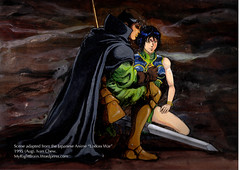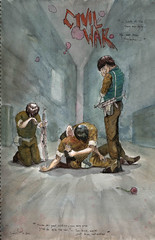

I'd almost forgotten I had them scanned. I remembered them only after yesterday's dinner at Dan Ryan's Chicago Grill with Walter and Vanesssa.
It started with a conversation with Vannesa's mother
Quite unplanned, Vanessa invited Walter and I to look at her home music studio. Over at her home, we met her parents. Her mother then showed us some paintings they'd collected over the years. We had an interesting chat about how Asians generally don't collect art works for the sake of appreciating the art pieces.
Walter said something about buying artworks as investment, but Vanessa's mum (whom we were warned not to call "Aunty" 'cos she's not that old, LOL) countered that there were better and surer ways in investing one's money. I mostly kept quiet during the conversation. I was questioning my own assumptions about arts appreciation and collecting art.
Constraints?
Admittedly, I also tend to think of art as something that only the very rich can afford, and that those who buy art do so as a form of investment. Good art is not cheap. Or is it?
I know of some retailers who sell oil pieces that are mass produced. Their strategy is to buy in bulk from the artists, and therefore sell at a more affordable price to the masses. Pretty nice pieces too. The shop that I know has been around for a few years, so it's business strategy must be working to some extent.
OK, maybe the lack of space is an issue. But one can buy little art pieces, or trade them. Maybe a BookCrossing equivalent for paintings and illustrations (hmm... I just might submit it to iJAM.sg).
Money and space isn't really the main issue. I believe it's more of an attitude and mindset. Ideally it should start at home, but if adults don't understand it, then the answer most likely starts in schools.
Teaching arts in schools
Schools teach the arts. Art lessons serve to expose students to mediums and techniques they otherwise wouldn't take up on their own. But unfortunately, the classes also serve to reinforce in some students' personal perception that "I cannot draw" or "I'm bad in art".
I had loads of fun during art class. I didn't have to study for them, and I could get by quite easily with the little talent that I have towards drawing and painting. I always found art lessons very relaxing (if only Science, History and Math classes were the same). But more than half of my classmates would dread art classes because it was graded and they often failed.
Thinking back, I wonder why art should be graded. Sure, you have to show some application of technique. But to say an art piece "passes" or "fails", it doesn't make sense to me now that I think of it.
I'm not sure if art lessons in schools now incorporate "Art Appreciation". By "Art Appreciation", I don't mean forcing students to research on artists' backgrounds or write essays on the similarities and difference between Modernism and Expressionism. Of course they are useful to teach the kids, but they shouldn't be the focus of art appreciation.
If I were to teach an art class, I'd tell the kids that their art pieces must tell a story. Get the kids to tell a story through that art piece. And along the way, they pick up different mediums and techniques, which would inevitably influence the way their story is conveyed.
Even a still-life drawing of a tea-pot can tell a story. Is the surface smooth or rough? How to you convey that using watercolours as a medium? Did you see that tiny chip at the tip? And did you observe the play of light and shadows?
Grade their level of undestanding, not how talented they are in drawing
For a start, the grading system has to be more clear than "pass" or "fail". Students should be told their work would be graded according to dimensions like 'application of technique', 'creativity', 'expression' and 'level of analysis and observation".
Granted that these dimensions are also subjective, but the idea is to let the students know they are being graded for more than whether the teacher likes their work or not, or whether they have natural talents and abilities in the arts.
The kids don't have to be great artists. But they'd have to at least explain or demonstrate they have observed those aspects when they draw.
The point of art lessons
Art lessons, to me, shouldn't be about "How well you can draw or paint" (if you can, it's a bonus). It should be about how well you observe the little things in life. It's about training your mind's eye to look at things which you might not have noticed before. It's about reading the story being conveyed from the medium.
Then maybe, people will start buying art for art's sake.

Thanks for your thoughts. I agree with the point that art shouldn't be graded. It's very subjective, and when children are graded poorly, it can be discouraging.
ReplyDeleteImagine if all the top artists in the world were gathered together as children and asked to draw/paint something. I wonder how our teachers would grade them. Would Einstein have survived here? He might have ended up in the Normal stream.
Raise your hands if you've heard the advice (usually from teachers or parents), "Art not important. Maths, can score." In a very competitive environment, we tend to take subjects that can get us full marks. It's harder to do that with Art, Literature, History, etc. So their 'value' is lower.
And when we finally grow up and can afford to buy art, it's little surprise that we also try to 'score' with it.
Interesting views on an age-old issue.
ReplyDeleteHeard about how Singapore has transformed from 3rd world to 1st world in one generation? Well, one of its outcomes are that our people are still pretty much in a "bread-and-butter" mode. We value economic success above the humanities and are very bottom-line driven and results oriented. As such, the intangibility and open-endedness of art makes it difficult for many to grasp.
I agree that one doesn't need to be an art historian to appreciate art. You can appreciate art for what it is, rather than try to be an acclaimed art critic. However, one needs to start from somewhere. I am happy to report that there are now a lot more art appreciation courses available to educate the man-in-the-street.
Despite the above, we have made much progress over the last decade or so. Attendances at museums, visual art shows and performing art events have increased year by year. I also see more youths embracing the arts and learning to appreciate its many subtleties and flavours.
One thing which the artistic community loves to do is discourse (Hmmm... sounds like the blogging community!). While debate is good and helps to advance scholarship and learning, what we perhaps also need is greater arts activism for the masses.
We need to break down the intimidation factor which comes from associating art with the affluent. People must see that everybody can love and collect art, and there are different entry points. Maybe only then can we all learn to appreciate the finer things in life?
Thanks for this post. I think teachers play quite a critical role in encouraging the appreciation of arts.
ReplyDeleteHave you thought of teaching a class of art, say as a volunteer to any of the social service agencies?
Hi OceanSkies, volunteering at a social service agency... no I haven't thought of that. You'd think they'd want my service? I'd be happy to explore.
ReplyDelete